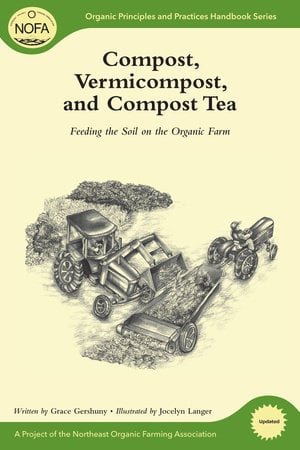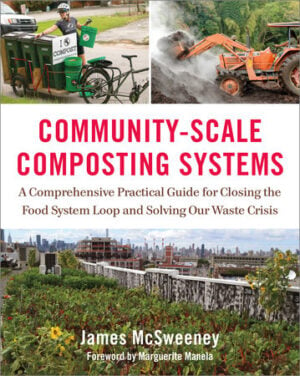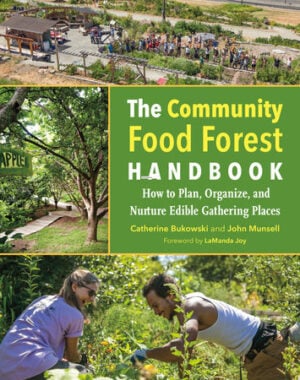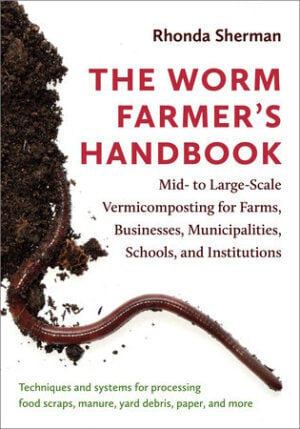The Worm Farmer’s Handbook
Mid- to Large-Scale Vermicomposting for Farms, Businesses, Municipalities, Schools, and Institutions
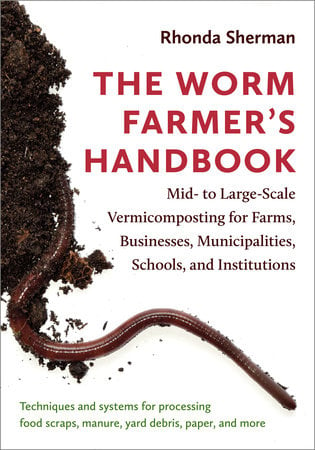
| Pages: | 256 pages |
| Book Art: | Full-color photographs illustrations throughout |
| Size: | 7 x 10 inch |
| Publisher: | Chelsea Green Publishing |
| Pub. Date: | October 19, 2018 |
| ISBN: | 9781603587792 |
The Worm Farmer’s Handbook
Mid- to Large-Scale Vermicomposting for Farms, Businesses, Municipalities, Schools, and Institutions
Choice Reviews, Outstanding Academic Title
Techniques and systems for processing food scraps, manure, yard debris, paper, and more
Turning waste into wealth sounds too good to be true, but many worm farmers are finding that vermicomposting is a reliable way to do just that. Vermicast—a biologically active, nutrient-rich mix of earthworm castings and decomposed organic matter—sells for $400 or more per cubic yard. Compare that to regular compost, sold at about $30 a cubic yard, and you’ll see why vermicomposting has taken root in most countries and on every continent but Antarctica.
Vermicomposting is also one of the best sustainable solutions for organic waste management. Vermicomposting manure and crop wastes on farms improves crop yields while reducing demand for off-farm inputs. Vermicast has higher nutrient levels and lower soluble salt content than regular compost, and it improves soil aeration, porosity, and water retention. Plus, vermicast suppresses plant diseases and insect attacks. Municipalities, businesses, community gardens, schools, and universities can set up vermicomposting operations to process food residuals and other waste materials.
The Worm Farmer’s Handbook details the ins and outs of vermicomposting for mid- to large-scale operations, including how to recycle organic materials ranging from food wastes and yard trimmings to manure and shredded office paper. Vermicomposting expert Rhonda Sherman shares what she has learned over twenty-five years working with commercial worm growers and researchers around the world. Her profiles of successful worm growers across the United States and from New Zealand to the Middle East and Europe describe their proven methods and systems.
This book digs into all the details, including:
- Choosing the right production system
- Regulatory issues and developing a business and marketing plan
- Finding and managing feedstocks
- Pre-composting: why and how to do it
- Monitoring an active worm bed
- Harvesting, screening, testing, packaging, and storing vermicast
- Markets for earthworms and vermicast
- Food security: how vermicast benefits soils and plants
- Keys to success: avoiding common pitfalls
From livestock farms and restaurants to colleges, military bases, and prisons, Sherman details why and how commercial-scale vermicomposting is a fast-growing, sustainable solution for organic waste management. The Worm Farmer’s Handbook is the first and only authoritative how-to guide that goes beyond small-scale operations and demystifies the science and logistics of the fascinating process that is vermicomposting.
Reviews & Praise
"Sherman offers an important addition to the literature on vermiculture and vermicomposting with an eyes-wide-open approach to planning, starting, and managing a viable commercial-scale operation that steers clear of hype while weighing both the risks and rewards of the venture."—Library Journal
"Vermiculture, the process of using worms to turn organic food waste into compost, has been around for decades but has been growing in popularity. Vermicompost or vermicast, the product of vermiculture, makes a rich, organic soil amendment or growth medium which has been shown to increase yields, reduce the damage caused by some diseases and pests, and help repair damage to degraded soil. This book covers everything one would want to know about vermiculture, from how it works to designing a harvesting system and laying out postharvest practices. Sherman also profiles a range of worm-farming examples from throughout the U.S. and around the world, including details such as the size of the operation and its setting, the cost of setup, the amount of food waste processed, and the span of time the process takes. While written for use in a mid- or large-scale setting, much of the information here about earthworm biology and living conditions will also be beneficial for smaller-scale use by home gardeners.”—Booklist
“In my 24 years in the worm business, I have read and sold many books about worms. The Worm Farmer’s Handbook is the most comprehensive and detailed collection of information on vermicomposting I have encountered. Rhonda Sherman provides clear instructions and guidance on everything a beginner needs to know to start up and successfully maintain a worm business, from type of beds and feedstocks to how to feed, harvest, package, ship, and much more. Experienced farmers will find plenty of excellent tips and ideas to improve their businesses, too. Well done, Rhonda!”—Mark Purser, co-owner, The Worm Farm, Durham, California
“My very first business venture as a child was a worm farm, which failed horribly. Had I had Rhonda Sherman’s mentorship, I can only imagine the worm empire I’d have today. With The Worm Farmer’s Handbook as a guide, anyone can learn the science and art of raising worms.”—Tony Hsieh, CEO, Zappos; author of Delivering Happiness
“Rhonda Sherman masters the art of communicating the technical and biological minutia critical to successful worm farming in a personable and easy-to-understand manner. The case studies in The Worm Farmer’s Handbook bring vermicomposting alive! This book is the next best thing to being on an actual worm farm tour. Kudos!”—Nora Goldstein, editor, BioCycle magazine
“Rhonda Sherman’s book has arrived on the scene at just the right time, as vermiculture technology is gaining momentum in research and industry. The book combines Sherman’s hands-on experience with detailed descriptions of current practices and comprehensive documentation of research findings, making it a vital reference for worm farming practitioners and enthusiasts.”—Norman Q. Arancon, PhD, associate professor of horticulture, University of Hawaii at Hilo
“The Worm Farmer’s Handbook is a must-read for anyone interested in vermicomposting or vermiculture. With a candid voice, Rhonda Sherman explains the pitfalls and opportunities of worm farming based on her decades of experience. Chock full of tips for replication and lessons learned from model enterprises, the book’s chapters span not only the globe but a plethora of systems and sizes.”—Brenda Platt, director, Composting for Community Project, Institute for Local Self-Reliance
“With The Worm Farmer’s Handbook, Rhonda Sherman delivers the first concise book of its kind: The A through Z of vermicomposting for commercial and community-scale enterprises.”—Frank Franciosi, executive director, US Composting Council
“Rhonda Sherman sheds light on the mysterious world of worms and provides valuable insight into the worm composting industry. The Worm Farmer’s Handbook is my new first stop for practical, trustworthy vermicomposting information.”—James McSweeney, author of Community-Scale Composting Systems
“Rhonda Sherman’s comprehensive new manual covers everything about creating a vermiculture business, from writing a business plan, marketing, and the care and feeding of worms to choosing a system that works for you. I wish her book had been available when I bought my worm farm 25 years ago! For over 20 years I have believed that vermiculture has the potential to revolutionize agriculture. The Worm Farmer’s Handbook can help that revolution go forward, and I heartily recommend this book to anyone interested in vermiculture.”—Jack Chambers, president, TerraVesco
“Before reading this book, I made a mental note of topics that I felt would be included, such as history, how-to, underlying science, pitfalls and benefits, and economics. I was not disappointed—these topics and so much more are fully covered and written about in a very readable manner. This book will prove useful to academics and students at every educational level, practitioners of all types, and anyone with an enquiring mind. In an ever-growing field, The Worm Farmer’s Handbook is set to be the must-have guide and is a very welcome addition to earthworm literature.”—Kevin R. Butt, PhD, director, Earthworm Research Group, University of Central Lancashire
“With global topsoil depletion reaching alarming levels, this thorough, informed, detailed, and concise manual could not be more timely. Worm farming presents unprecedented hope and enterprising opportunities that are being adopted in every corner of the world. All food security activists, healthy soil advocates, farmers, and educators should read The Worm Farmer’s Handbook. Thank you, Rhonda—this book is a highly useful gift to us all. The world needs more worm farmers!”—Anna de la Vega, director, The Urban Worm Community Interest Company



